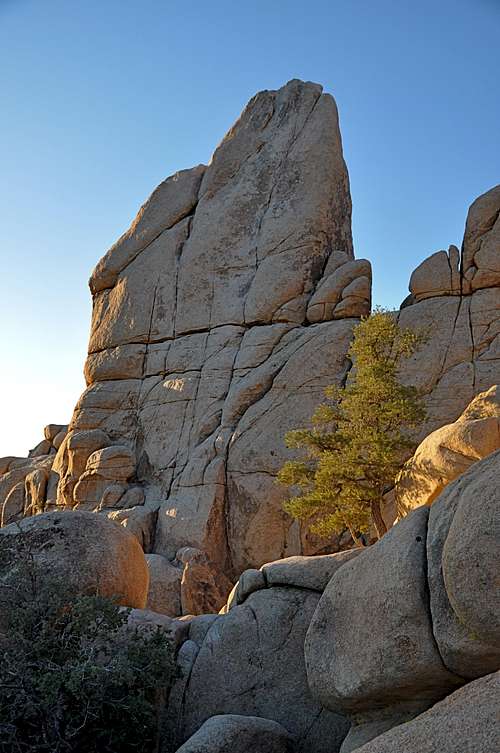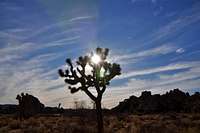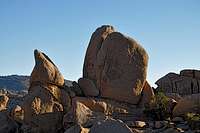-
 7336 Hits
7336 Hits
-
 95.35% Score
95.35% Score
-
 52 Votes
52 Votes
|
|
Mountain/Rock |
|---|---|
|
|
34.01425°N / 116.168°W |
|
|
Riverside |
|
|
Trad Climbing |
|
|
Spring, Summer, Fall, Winter |
|
|
Overview
Hidden Tower is a beautiful rock formation located in the “Real Hidden Vally.” Even though, its height is relatively low, about 75 feet, it sports an extremely popular climb called “Sail Away.”On my last visit to Hidden Tower three different teams of climbers arrived within one half hour to take turns on “Sail Away.” Hidden Tower is north facing, hence it stays in the shade all day long making its north face routes desirable for warmer seasons. Joshua Tree National Park is considered a high desert area with average alltitude of 4000 feet. During late spring and summer months when the temperatures easily top 100 F degrees, all the north facing formations become much sought after. It’s during these periods that “Sail Away” becomes a destination of choice.
Another great climb not to be ignored and forgotten is "Wild Wind, 5.9." This climb flollows the obvious crack system to the left of Sail Away.
Sail Away, 5.8
Sail Away is a beautiful hand crack rated at 5.8. The starting moves are quite easy and the main crack stays consistently at 5.8. There are no bolts on this climb, but you can put in as many pieces of protection as you like. Take a standard rack of nuts and cams up to 2 inches.
Thanks to the rebolting efforts of some dedicated climbers, the old rusty rappel bolts on top have been replaced with new ones. One sixty meter rope is perfectly suitable for rapping off. Hidden Tower and Sail Away will draw you back again and again.
camping and Noise Considerations
There are nine campgrounds in Joshua Tree National Park. At the entrance to the park you are always asked if you would care to have a map and a brochure. The brochure will have plenty of information on the campgrounds and the map will guide you to many of the pleasant hikes throughout the park. You may even get the latest information as to availability of campsites. During the peak season (mid winter through spring) finding a campsite may become a major task. It is highly recommended to make reservations in advance.Noise considerations,
When you are camping with friends and sitting around the fire, it is easy to forget that there are other people trying to sleep in the nearby campsites. It is important to put yourself in their shoes. Keep the noise and music to a minimum and certainly not too much past 10 p.m. Your neighbors will smile at you in the morning instead of giving you dirty looks.
For current Campground information please see the link bellow:
Joshua Tree Camping
Environmental considerations
Please tread lightly. The Access Fund has gone to great lengths posting trail marker for approaches to many of the more popular crags. Do your best to stay on these trails, and where you are forced to use a different path, choose the ones that rain can mend in time. Drainages make for good trails where there are no established trails.
Avoid stepping on native and fragile plants, and do not feed the coyotes. Coyotes are very much used to people and often hang around picnic areas and camp grounds in hopes of getting a hand out. It’s better to let them live their natural life.
How to get there

Sport Challenge Rock. You will see this rock on your left during the approach to the north side of Hidden Tower.
From the western entrance to Joshua Tree National Park drive on Park Boulevard, formerly known as Quail Springs Road, for about nine miles to a major rock formation called “Intersection Rock.” Intersection Rock is a major landmark on the north side of Park Boulevard with ample parking for visitors and climbers alike. This rock, true to its name, sit at the cross roads to Hidden Valley Campground, Barker Dam Road and the road to Day use and picnic area.
Turn right onto the road leading to day use area with a large parking lot and bathrooms. The Trail to “Real Hidden Vally” is obvious and starts here. This trail leads to “Nature Loop Trail” and “Real Hidden Valley.”
When you get to the Loop Trail take the right fork. After a few minutes you will see a large and steep blocky rock formation to your left. That’s Sport Challenge Rock. Hidden Tower is beyond and to the north east of this formation. The south face of Hidden Tower doesn’t look anything like a tower and can be seen from the main loop trail. Refer to the photo posted here in this page. Once you recognize the south face of Hidden Tower you should have no problem finding the North Face of it.
Red Tape
There are no permits required to climb or hike in Joshua Tree National Park. However, there are fee requirements for entering and camping within the park boundaries.7-Day pass for each passenger car---$15
7-Day pass on foot, bicycle or motor cycle ---$5
Joshua Tree Annual Pass/non transferable---$30
Interagency Annual Pass---$80
Campsite fees are $15/night for Black Rock, Cottonwood and Indian Cove campgrounds.
The fees for the remaining campgrounds are $10/ night.








